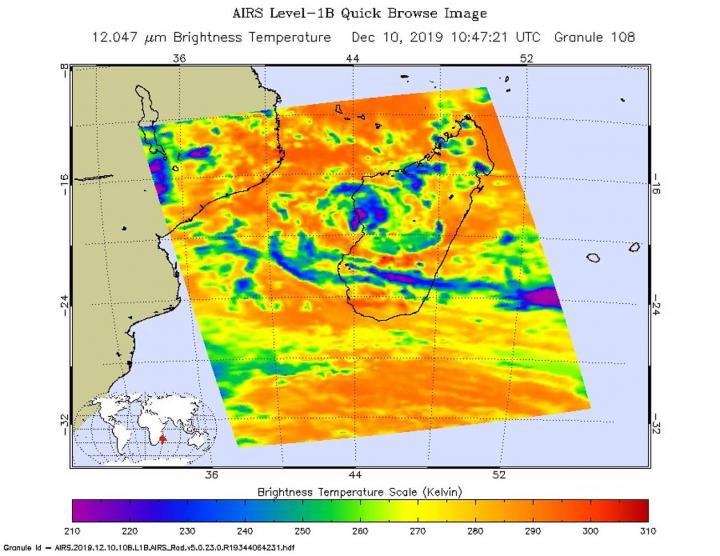
Credit: Credit: NASA JPL/Heidar Thrastarson
Tropical Storm Belna weakened after it made landfall in northwestern Madagascar, and infrared imagery from NASA showed how the area of strong storms within had diminished. Cold cloud top temperatures can tell forecasters if a tropical cyclone has the potential to generate heavy rainfall, and that is exactly what NASA’s Aqua satellite found on Dec. 10 over a much smaller area than was occurring on Dec. 9.
The AIRS instrument aboard NASA’s Aqua satellite captured a look at cloud top temperatures in Belna which gave insight into the storm’s strength. Cloud top temperatures provide information to forecasters about where the strongest storms are located within a tropical cyclone. Tropical cyclones do not always have uniform strength, and some sides are stronger than others. The stronger the storms, the higher they extend into the troposphere, and the colder the cloud temperatures are.
On Dec. 10 at 6:47 a.m. EST (1047 UTC) NASA’s Aqua satellite analyzed the storm using the Atmospheric Infrared Sounder or AIRS instrument. AIRS found the strongest storms with coldest cloud top temperatures as cold as or colder than minus 63 degrees Fahrenheit (minus 53 degrees Celsius) in a small area over northwestern Madagascar. NASA research has shown that cloud top temperatures that cold indicate strong storms that have the capability to create heavy rain.
By Dec. 11 at 4 a.m. EST (0900 UTC), Belna had become devoid of all heavy rainfall, and the forecasters at the Joint Typhoon Warning Center (JTWC) issued their final bulletin on the storm. Belna had weakened to a tropical depression and had maximum sustained winds near 30 knots (34.5 mph/55.5 kph).
Belna was located near latitude 21.3 degrees south and longitude 45.4 degrees east. It was over land and just six nautical miles southwest of Antananarivo, Madagascar. Belna was moving south and is expected to dissipate in a day or two.
Tropical cyclones and hurricanes are the most powerful weather events on Earth. NASA’s expertise in space and scientific exploration contributes to essential services provided to the American people by other federal agencies, such as hurricane weather forecasting.
The AIRS instrument is one of six instruments flying on board NASA’s Aqua satellite, launched on May 4, 2002.
###
Media Contact
Rob Gutro
[email protected]
Original Source
https:/




